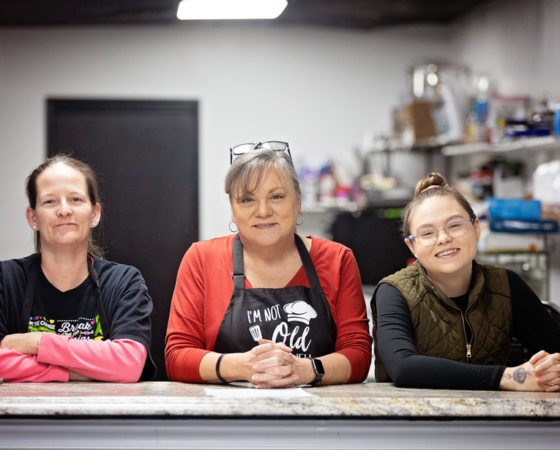School consolidation has become a significant issue in Appalachia, as in many rural areas. Just witness the storm of controversy over planned consolidation of elementary schools in Letcher County, Kentucky. Consolidation is used as a cost-cutting measure that closes smaller schools and moves students to larger, more centralized facilities. Consolidated schools may offer newer buildings, more extracurriculars and more modern technology, but they also often result in long bus rides for children and a loss of community. In this heartfelt piece from the Daily Yonder, a writer from West Virginia, laments the closing of her little school in Nicholas County.
The Heartbreak of a Closed School
 Betty Dotson-Lewis This is all that's left of our Canvas school (left). It serves now as a meeting place for a Ruritan club.
Betty Dotson-Lewis This is all that's left of our Canvas school (left). It serves now as a meeting place for a Ruritan club.
Where did you go to school?
Were you one of the lucky ones who lived in a rural school district with small schools, good teachers, good administrators and support personnel who treated you as if you were their own? Were you fortunate enough to go to school where you were a real student instead of just a number?
I was.
I attended Canvas Grade School in Canvas, Nicholas County, West Virginia in the Appalachian coalfields. Canvas Grade School was near the end of the Ward Road where we grew up on a farm surrounded by coalminers and farmers.
Canvas Grade School was the focal point of the Canvas community. The school was a basic cinder block and mortar structure painted a sick yellow. The building held classrooms for grades K-8, a long hallway, and a lunch room. Enrollment varied between 100-120.
The school was not much to brag about visibly, but it was what was inside that counted.
Our lives revolved around our home, church and school. We went to our school for 4-H Club meetings, dances, voting, community dinners and sports events. Our school was a safe haven for weary students, a source of healthy, home-cooked meals, a clothing bank — a building filled with dedicated people who hugged you, corrected you, encouraged you and presented opportunities for achievement. Our grade school friends became friends for life-we shared so much.
You could say Canvas Grade School to the residents of Canvas held the same rank and distinction as the Taj Mahal to the people of India. One difference: The Taj Mahal still stands and Canvas Grade School in 1994 was dissolved, demolished and leveled to the ground in the name of school consolidation.
Canvas, Nettie and Leivasy
Three elementary schools — Canvas, Nettie, and Leivasy — were consolidated into a new, 255-student facility. Parents were told there was no other way and this would result in cost savings to the local district in transportation, repairs and personnel by reducing two administrator positions.
 Betty Dotson-Lewis The Birch River Grade School (right) was a West Virginia School of Excellence in 2011. Total enrollment: 101.
Betty Dotson-Lewis The Birch River Grade School (right) was a West Virginia School of Excellence in 2011. Total enrollment: 101.
The new school was built in a new location in Nettie and named Panther Creek Elementary after the Panther Creek tributary running through that end of the county. It was a festive day in 1995 for the West Virginia School Building Authority, West Virginia Department of Education and Governor Gaston Caperton, who flew up in a helicopter. (The pilot landed on the playground.)
But the closing and consolidation of these three rural schools disrupted the entire educational system in Nicholas County. At least two communities (Canvas and Leivasy) were losing their school, the heart of their communities. Canvas was hit especially hard due to the fact it was a thriving, well-established school and community with parents active in everything from PTO to volunteer tutoring.
Also, the new school disrupted long-standing relationships between communities and high schools.
Canvas Grade School students attended Nicholas County High School and students from Nettie Grade School and Leivasy Grade School were feeder schools for Richwood High School. The rivalry between Nicholas County and Richwood was a Hatfield/McCoy chapter.
Feuds ranged from school name to school colors for the new consolidated school, which included students from both sides of the county. Board members, in an effort to appease parents and hopefully get re-elected or get the next county levy passed, promised parents from Nettie that their students could attend the high school of their choice, Nicholas County or Richwood. Those promises were soon forgotten as board members resigned did not seek re-election, or were defeated.
Transportation didn’t improve either. Students coming out of the hollows started their day as early as 6:10 a.m.
Losing a Family — and a Good School
Losing one’s small rural school is like losing a member of the family. The school in a small community is an extension of the family. No, the very mention of school consolidation can set tempers on fire in the mildest mannered, church-going homemaker/mother and can make an orator out of an otherwise silent farmer or coalminer in front of a packed house at a local school board meeting.
Perhaps parents and rural community members who love and support their small schools are reacting from a gut feeling that school consolidation is not in the best interest of their child.
West Virginia has been recognized as a leader in school consolidation and education experts use a couple of selling points to defend the closing of these rural schools: a great amount of money saved by the county and state; there are advantages of larger classrooms and modern science labs; larger cafeterias will have more choices for meals; and all the latest tech will be at students’ finger tips.
Were these educational gurus actually convinced larger classrooms containing more students in modern buildings with up-to-date technology would solve the problems of the rural students in a district where 52% of the student population is eligible for free or reduced lunches? Is a big school really better for rural students if they are lost in the crowd or can no longer participate in after school activities because of the lack of transportation?
West Virginia has been consolidating schools through the School Building Authority since it was created in 1989. Within the first five years, 258 schools were closed. The School Building Authority mandates minimum sizes for schools. If they aren’t big enough, they don’t get built.
West Virginia continues to lose population since the SBA was created in 1989 but the minimum school sizes have not decreased proportionally. Travel time guidelines for bus rides for West Virginia students is no more than 30 minutes for elementary students, 45 minutes for middle schools, and 60 minutes for high schools students. But elementary school children are still boarding buses as early as 6:10 A.M.
An Audit Questions Consolidation
 Betty Dotson-Lewis My brother drove across the country hoping to show his wife where he went to school (left). The school was gone.
Betty Dotson-Lewis My brother drove across the country hoping to show his wife where he went to school (left). The school was gone.
A year ago, an audit of the West Virginia Department of Education (PE 09-w0-466) provided statistics and other data backing up parents’ gut feeling that consolidation of small rural schools is not necessarily good for students. The state’s graduation rate had not improved in 15 years, and one of the reasons could be that the state’s schools were too large.
Here is some of what the audit found:
It is apparent that large high schools in West Virginia have negative influences on the dropout and graduation rates that are distinct from academic performance.
These negative influences are more likely associated with the school environment, student attitudes towards the school, and a lack of interpersonal relationships with faculty members. However, larger high schools and class sizes are only a part of the influences that come from larger district sizes. Other factors are having a negative influence on the graduation rates that are not easy to measure.
As a result of the multi-faceted issues that affect the graduation and dropout rates that are derived from larger districts, there is a need for a comprehensive approach to overcome the obstacles to improving the state’s high school graduation rate. Part of that approach must include a DOE study of the full impact that school consolidation is having on education outcomes, such as the graduation rate.
To those who hold on to memories, important events and people, Canvas will never be the same without Canvas Grade School. It was more than a cinder block building painted a sick yellow; more than a couple of tire swings tied to one of the trees or a hop scotch pattern on a side walk.
Canvas Grade School held the community together: students, parents, teachers and community leaders.
One of my five brothers made his home in the State of Washington. He made a cross-country trip, traveling the path he’d hitchhiked when a young man. One of the highlights of this trip was to show his wife Canvas Elementary.
He was heartbroken to find out his school no longer existed even though the community was thriving and people were building homes. He said that it made no sense to close such a good school only to bus students a greater distance from their homes. My brother is outspoken and served as president of the PTA in his own district out west.
West Virginia has been creating bigger schools and larger classrooms for more than 20 years. We’ve proved that the one-size-fits all (larger) school does not save money and creates a personal and social loss not reflected on any balance sheet.
Betty Dotson-Lewis is a native of Nicholas County, West Virginia, and a regular Daily Yonder contributor.





